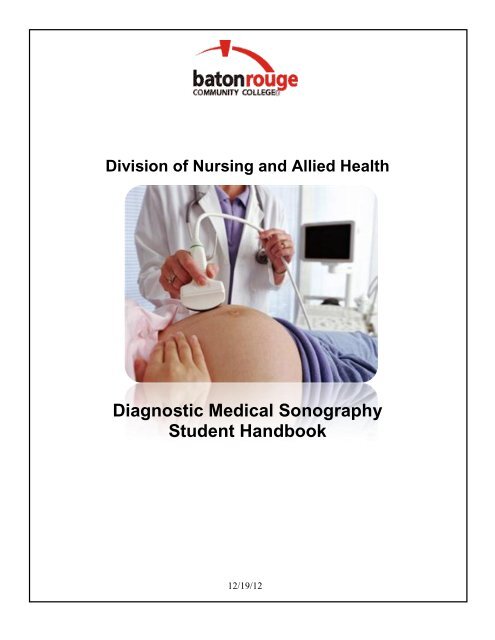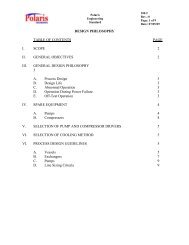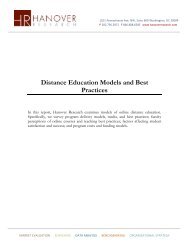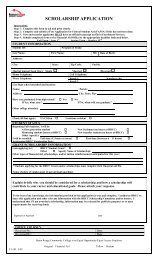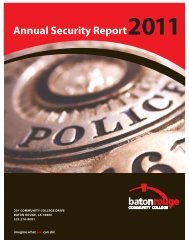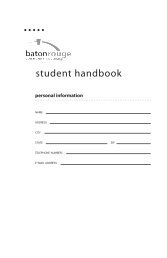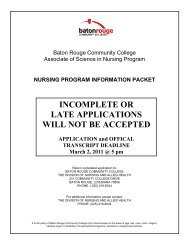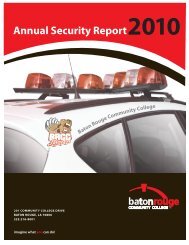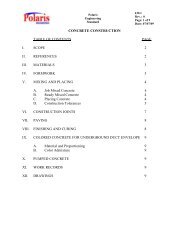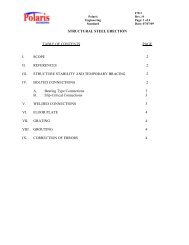Diagnostic Medical Sonography Student Handbook - Baton Rouge ...
Diagnostic Medical Sonography Student Handbook - Baton Rouge ...
Diagnostic Medical Sonography Student Handbook - Baton Rouge ...
Create successful ePaper yourself
Turn your PDF publications into a flip-book with our unique Google optimized e-Paper software.
Division of Nursing and Allied Health<br />
<strong>Diagnostic</strong> <strong>Medical</strong> <strong>Sonography</strong><br />
<strong>Student</strong> <strong>Handbook</strong><br />
12/19/12<br />
1
12.19.12 2<br />
TABLE OF CONTENTS<br />
INTRODUCTION ............................................................................................................... 4<br />
MISSION STATEMENTS .................................................................................................. 4<br />
PURPOSE ......................................................................................................................... 4<br />
SONOGRAPHY PROGRAM OUTCOMES ....................................................................... 5<br />
NON-DISCRIMINATION ................................................................................................... 5<br />
TRANSFER CREDIT ......................................................................................................... 5<br />
ADMISSION REQUIREMENTS ........................................................................................ 5<br />
HEALTH AND CLINICAL REQUIREMENTS ..................................................................... 6<br />
Dress Code ............................................................................................................... 6<br />
Change of Health Status ........................................................................................... 7<br />
Health Insurance ....................................................................................................... 7<br />
Professional Liability Insurance ................................................................................. 7<br />
Health Insurance Portability and Accountability Act (HIPAA) of 1996 ....................... 8<br />
GRADUATION REQUIREMENTS..................................................................................... 8<br />
American Registry of <strong>Diagnostic</strong> <strong>Medical</strong> <strong>Sonography</strong> Examination ......................... 8<br />
FACULTY / STUDENT COMMUNICATION .............................................................. 8<br />
Communication of Changes ...................................................................................... 8<br />
Instructor Conferences .............................................................................................. 8<br />
Course Information .................................................................................................... 9<br />
STUDENT CONDUCT ...................................................................................................... 9<br />
Cell Phones and Personal Electronic Devices .......................................................... 9<br />
<strong>Student</strong> Organizations ............................................................................................... 9<br />
STUDENT RESOURCES .................................................................................................. 9<br />
Advising, Counseling, and Career Services (ACCS) ................................................. 9<br />
Office of Disability Services (ODS) ............................................................................ 9<br />
<strong>Student</strong> Financial Assistance .................................................................................... 10<br />
Library Facilities ........................................................................................................ 10<br />
Testing Center ........................................................................................................... 10<br />
Computer Access ...................................................................................................... 10<br />
POLICIES .......................................................................................................................... 11<br />
ATTENDANCE POLICY .................................................................................................... 11<br />
Credit and Clock Hours ............................................................................................. 11<br />
Class Attendance ...................................................................................................... 11<br />
Clinical Attendance ................................................................................................... 11<br />
TESTING AND GRADING POLICY .................................................................................. 11<br />
Theory Evaluation .................................................................................................... 11<br />
Grading Scale .......................................................................................................... 12<br />
Posting Grades ........................................................................................................ 12<br />
Test Review ............................................................................................................. 12<br />
Make-up Examinations ............................................................................................ 12<br />
Clinical Evaluation.................................................................................................... 12<br />
Guidelines for Written Work ..................................................................................... 12<br />
College Holidays, Mid-Term and Final Examination Schedules ................................ 13<br />
CLINICAL, PRACTICUM POLICY ..................................................................................... 13<br />
Clinical Safety ........................................................................................................... 13
Professional Behavior .............................................................................................. 13<br />
Professional Ethics and Confidentiality ..................................................................... 14<br />
Unsafe Clinical, Practicum Practices ......................................................................... 14<br />
Physical Safety .......................................................................................................... 14<br />
Biological Safety ........................................................................................................ 14<br />
Emotional Safety ....................................................................................................... 14<br />
Unprofessional Practice ............................................................................................ 14<br />
Progressive Discipline Procedure ............................................................................. 15<br />
Step 1: Warning ........................................................................................................ 15<br />
Step 2: Conference ................................................................................................... 15<br />
Step 3: Probation ...................................................................................................... 15<br />
Step 4: Dismissal ...................................................................................................... 16<br />
RETENTION, PROGRESSION, DISMISSAL POLICY ...................................................... 16<br />
Retention, Progression .............................................................................................. 16<br />
Dismissal ................................................................................................................... 16<br />
Readmission ............................................................................................................. 17<br />
Appeal Process ......................................................................................................... 17<br />
SUBSTANCE ABUSE AND DRUG TESTING POLICY ..................................................... 17<br />
Substance Abuse ...................................................................................................... 17<br />
Substance Abuse Testing Procedure ........................................................................ 17<br />
APPENDICES ................................................................................................................... 19<br />
12.19.12 3
BATON ROUGE COMMUNITY COLLGE<br />
DIAGNOSTIC MEDICAL SONOGRAPHY<br />
ASSOCIATE OF SCIENCE PROGRAM<br />
INTRODUCTION<br />
The <strong>Baton</strong> <strong>Rouge</strong> Community College <strong>Sonography</strong> <strong>Student</strong> <strong>Handbook</strong> has been<br />
compiled by the faculty to provide information pertinent to students enrolled in the<br />
<strong>Sonography</strong> Program offered at BRCC. The faculty and staff wish you success in the<br />
pursuit of your educational goals.<br />
The <strong>Sonography</strong> <strong>Student</strong> <strong>Handbook</strong> provides detailed procedures and policies specific<br />
to the <strong>Sonography</strong> Program. This handbook is to be used as a supplement to the <strong>Baton</strong><br />
<strong>Rouge</strong> Community College <strong>Student</strong> <strong>Handbook</strong> and College Catalog, and serves to<br />
bridge the overriding policies of the College with the policies specific to this program.<br />
The information, policies and procedures set forth in this handbook are designed to<br />
support the success of the student.<br />
MISSION STATEMENTS<br />
<strong>Baton</strong> <strong>Rouge</strong> Community College<br />
The mission of <strong>Baton</strong> <strong>Rouge</strong> Community College is to identify and meet the educational<br />
and workforce needs of our community through innovative, accessible, and dynamic<br />
programs.<br />
Allied Health Department<br />
The mission of the Allied Health department is to educate competent health care<br />
professionals who will enhance the quality of life of individuals in a dynamic and diverse<br />
society.<br />
<strong>Diagnostic</strong> <strong>Medical</strong> <strong>Sonography</strong> Program<br />
The mission of the <strong>Diagnostic</strong> <strong>Medical</strong> <strong>Sonography</strong> Program at <strong>Baton</strong> <strong>Rouge</strong><br />
Community College is to prepare qualified candidates to perform the duties of the entrylevel<br />
diagnostic medical sonographer. The <strong>Diagnostic</strong> <strong>Medical</strong> <strong>Sonography</strong> Program<br />
strives to instill the knowledge, skills, abilities, values, and essence of teamwork. Our<br />
goal is to provide the Allied Health workforce with highly qualified Sonographers who<br />
will deliver personalized, high quality healthcare while still preserving the dignity of<br />
every person by providing compassion and care of the highest standard.<br />
PURPOSE<br />
The purpose of the Program of <strong>Diagnostic</strong> <strong>Medical</strong> <strong>Sonography</strong> is to provide<br />
educational opportunities for individuals to acquire the necessary knowledge, skills,<br />
values, and competencies for <strong>Sonography</strong> practice. The curriculum is based on the<br />
Standards and Guidelines of the Joint Review Committee on Education in <strong>Diagnostic</strong><br />
<strong>Medical</strong> <strong>Sonography</strong> (JRC-DMS), for Graduates of Associate Degree <strong>Sonography</strong><br />
Programs. Graduates will receive the associate of applied science degree in <strong>Diagnostic</strong><br />
<strong>Medical</strong> <strong>Sonography</strong> and are eligible to apply to write the American Registry of<br />
12.19.12 4
<strong>Diagnostic</strong> <strong>Medical</strong> <strong>Sonography</strong> (ARDMS) Examinations in <strong>Sonography</strong> Principles and<br />
Instrumentation, Abdomen, and OB/GYN (RDMS-Abdomen, RDMS-OB/GYN).<br />
SONOGRAPHY PROGRAM OUTCOMES<br />
1. Obtain, review, and integrate pertinent patient history and supporting clinical data<br />
to facilitate optimum diagnostic results.<br />
2. Recognize the importance of patient care and comfort.<br />
3. Perform appropriate procedures and record anatomic, pathologic, and<br />
physiologic data for interpretation by a physician.<br />
4. Demonstrate measures of fiscal responsibility.<br />
5. Record, analyze, and process diagnostic data and other pertinent observations<br />
made during the procedure for presentation to the interpreting physician.<br />
6. Demonstrate sound clinical judgment in the performance of sonographic and<br />
other diagnostic services.<br />
7. Demonstrate appropriate communication skills with patients, families and<br />
colleagues.<br />
8. Demonstrate professionalism and ethical behavior.<br />
9. Provide patient education related to medical ultrasound and other diagnostic<br />
procedures.<br />
NON-DISCRIMINATION<br />
It is the policy of <strong>Baton</strong> <strong>Rouge</strong> Community College not to discriminate on the basis of<br />
age, sex, race, color, religion, national origin or disability in its educational programs,<br />
activities or employment policies.<br />
TRANSFER CREDIT<br />
BRCC’s Office of Enrollment Services evaluates transcripts for degree-seeking students<br />
in their first semester at BRCC. Transfer credits from regionally-accredited institutions of<br />
higher education are recorded on a student’s academic record (see BRCC Catalog for<br />
details). <strong>Sonography</strong> courses are generally not transferable from other institutions.<br />
ADMISSION REQUIREMENTS<br />
1. Must have completed BRCC admission requirements (Enrollment Services Office)<br />
2. Applicant must have a minimum GPA of at least 2.5 and a grade of "C" or higher<br />
in 29 credit hours of required courses which must include the following courses:<br />
Course No. Course Title Credit Hours<br />
MATH 101 or 110 College Algebra 3<br />
ENGL 101 English Composition I 3<br />
PSYC 201 Introduction to Psychology 3<br />
BIOL 230 Human & Anatomy Physiology I 4<br />
BIOL 231 Human & Anatomy Physiology II 4<br />
PHYS 200 Concepts in Physics 3<br />
HLSC 110 <strong>Medical</strong> Terminology 3<br />
PHIL 225 Biomedical Ethics 3<br />
HUMN 1 Art or Humanities Elective 3<br />
29<br />
1 To be selected from the Humanities General Education requirements listed in the current BRCC Catalog.<br />
12.19.12 5
3. The Health Occupations Basic Entrance Test (HOBET V) exam is required for all<br />
students applying to the <strong>Sonography</strong> program at BRCC and is one of the criteria<br />
used for admission into the program. The HOBET V exam is used to assess<br />
each student’s basic skills in reading, math, science, English and language.<br />
a. Admission exam fee is incurred by the student.<br />
b. The student is allowed to take the HOBET V exam once per application<br />
cycle. The minimum passing score accepted is 60. The admission exam<br />
score is valid for two (2) years. If not admitted during the initial application<br />
period, the student will be allowed to use a previous exam score, or they<br />
may choose to retake the admission exam. The most recent HOBET V<br />
exam score will be used for student ranking.<br />
4. If a large pool of qualified applicants exists interviews may be required.<br />
HEALTH AND CLINICAL REQUIREMENTS<br />
If accepted to the <strong>Sonography</strong> program additional health requirements are required, to<br />
include:<br />
1. Health history, physical examination, immunizations, and titers must be<br />
completed by personal physician or a healthcare provider.<br />
2. Urine drug screen must be completed at Total Occupational Medicine. All costs<br />
will be incurred by the student.<br />
3. Proof of current immunization status is required as a part of the physical<br />
examination before entry into clinical sonography courses. Required<br />
immunizations/titers include: Measles, Mumps & Rubella (MMR), Tetanus &<br />
Diphtheria (Td), Hepatitis B and Varicella.<br />
4. HIV status and results of a Rapid Plasma Reagin (RPR) are also required.<br />
5. Cardiopulmonary Resuscitation (CPR) for Health Care Providers and<br />
tuberculosis (Tb) testing is required annually.<br />
6. All completed health and medical records must be submitted to the <strong>Sonography</strong><br />
clinical coordinator by the published deadline.<br />
Dress Code<br />
<strong>Student</strong>s are required to conform to the uniform regulations as specified.<br />
1. Full uniform is required in clinical settings.<br />
Full uniform includes:<br />
Ladies<br />
a. Uniform Top: (Landau style: 8210; color: Black)<br />
b. Uniform Pants: (Landau style: 8320, color, Black)<br />
c. Uniform Jacket (Landau style: 7535; color: White)<br />
d. Maternity pant (Landau style: 8373; color: Black)<br />
e. Solid white closed heel and toe leather shoes<br />
f. Solid white hose or socks<br />
g. Official <strong>Baton</strong> <strong>Rouge</strong> Community College name tag<br />
Men<br />
a. Uniform Top: (Landau style: 8210; color: Black)<br />
b. Uniform Pants: (Landau style: 8320; color: Black)<br />
c. Uniform Jacket (Landau style: 7551; color: white)<br />
d. Solid white closed heel and toe leather shoes<br />
12.19.12 6
e. Solid white socks<br />
f. Official <strong>Baton</strong> <strong>Rouge</strong> Community College name tag<br />
2. In cold weather, a long sleeve black round neck t-shirt may be worn under the<br />
uniform top.<br />
4. Personal hygiene is expected to be maintained by each student. This includes:<br />
a. clean uniform, clean shoes and shoelaces<br />
b. neatly groomed hair (hair not extending below the shoulder level)<br />
c. long hair must be pulled back and up and held by a neutral color ponytail<br />
holder<br />
d. men must be cleanly shaven, females should have minimal facial<br />
cosmetics<br />
e. short, clean, and unpolished natural nails (not to extend beyond the<br />
fingertips); no artificial nails allowed at any time<br />
f. body art must not be visible while in uniform<br />
g. no use of perfumes, colognes, after-shave lotions and other body scents;<br />
use of fragrance-free deodorants and oral hygiene is required. <strong>Student</strong>s<br />
who smoke must be free of cigarette odor<br />
h. jewelry for women limited to a watch with second hand, wedding and/or<br />
engagement ring, one pair of small stud type earrings<br />
i. jewelry for men limited to a watch with second hand and wedding band;<br />
one pair of small stud type earrings, no other jewelry is allowed to be worn<br />
in the clinical setting.<br />
j. no visible body piercings allowed (including tongue piercing)<br />
5. Eating is prohibited in the skills lab and client care areas of the clinical settings.<br />
Chewing gum is not allowed when in clinical.<br />
6. Cell phones and personal electronic devices are to be turned off in the clinical<br />
setting.<br />
Change of Health Status<br />
<strong>Student</strong>s must submit a "Change of Health Status" form (see Appendix) if illness,<br />
surgery, hospitalization or pregnancy occurs after entry into clinical sonography<br />
courses.<br />
Health Insurance<br />
It is highly recommended that all students carry personal health insurance coverage.<br />
<strong>Student</strong>s are responsible for all health care costs sustained while enrolled in<br />
sonography courses.<br />
Professional Liability Insurance<br />
Proof of professional liability insurance is mandatory for all new and continuing students<br />
enrolled in clinical sonography courses. Liability insurance is a form of malpractice<br />
insurance. Failure to provide proof of insurance will result in a student not being<br />
allowed to progress in the sonography curriculum.<br />
12.19.12 7
Health Insurance Portability and Accountability Act (HIPAA) of 1996<br />
<strong>Student</strong>s will abide by the Health Insurance Portability and Accountability Act of 1996<br />
Public Law 104-191 (HIPPA) which protects the privacy and identification of clients in a<br />
health care organization.<br />
GRADUATION REQUIREMENTS<br />
To receive the Associate of Applied Science in <strong>Diagnostic</strong> <strong>Medical</strong> <strong>Sonography</strong> degree<br />
the student must:<br />
1. Follow the graduation requirement guidelines outlined in the (BRCC Catalog)<br />
2. Meet the deadlines for graduation applications as posted in the “Academic<br />
Calendar” found in the BRCC Catalog and website.<br />
3. Pay graduation fees to the Bursar’s Office. This fee is good for one year from the<br />
time the application is made. College commencement exercises are voluntary.<br />
Diplomas are mailed to graduates once all final college work is evaluated.<br />
4. <strong>Student</strong>s should anticipate the following expenses:<br />
a. American Registry for <strong>Diagnostic</strong> <strong>Medical</strong> <strong>Sonography</strong> (ARDMS) Exam<br />
fees: Each ARDMS examination (SPI, Abdomen and/or OB-Gyn) is $250<br />
each and includes a non-refundable $100 processing fee. A minimum of<br />
two exams are required.<br />
b. Group composite photo (optional).<br />
c. <strong>Sonography</strong> Pin (optional): Approximately $65.00.<br />
American Registry of <strong>Diagnostic</strong> <strong>Medical</strong> <strong>Sonography</strong> Examination<br />
Upon completion of the sonography program the graduate may be eligible to apply to<br />
the ARDMS to take the registry examination in SPI, Abdomen, and/or OB/Gyn. The<br />
examination is designed to test the knowledge, skills and abilities essential to the safe<br />
and effective practice of sonography at the entry level. Upon successful completion of<br />
these examinations, the graduate becomes registered to practice as a Registered<br />
<strong>Diagnostic</strong> <strong>Medical</strong> Sonographer, in the specialty examination(s) passed (Abdomen<br />
and/or OB-Gyn).<br />
FACULTY / STUDENT COMMUNICATION<br />
Communication of Changes<br />
Policies are published and updated as necessary. Changes communicated to students<br />
by verbal announcement, written announcement, e-mail, Blackboard, and by posting on<br />
the <strong>Sonography</strong> program website page.<br />
Instructor Conferences<br />
1. Faculty may initiate conferences with students at any time. Instances when a<br />
conference may be required include, but are not limited to:<br />
a. Failure to attain a “C” or better in any sonography course<br />
b. Unsatisfactory clinical progress.<br />
c. Violation of the BRCC <strong>Student</strong> Code of Conduct.<br />
2. The student may request a conference during regular office hours, or by<br />
appointment.<br />
12.19.12 8
Course Information<br />
Course syllabi are the primary source of course information. Detailed course syllabi are<br />
posted on Blackboard and made available to all students. Master course syllabi are<br />
available on the college website (www.mybrcc.edu).<br />
STUDENT CONDUCT<br />
Cell Phones and Personal Electronic Devices<br />
1. All personal electronic devices and cell phones must be off during class lectures,<br />
lab, and in clinical areas.<br />
2. <strong>Student</strong>s may not bring personal electronic devices or cell phones into<br />
classrooms on test days. Any student found with a cell phone or any other<br />
personal electronic device during testing will be asked to leave the room and will<br />
receive a “0” on that exam.<br />
<strong>Student</strong> Organizations<br />
<strong>Student</strong>s are encouraged to participate in professional, departmental and college<br />
sponsored clubs, organizations, and activities.<br />
STUDENT RESOURCES<br />
<strong>Sonography</strong> students should refer to the BRCC website (http://www.mybrcc.edu/), the<br />
BRCC <strong>Student</strong> <strong>Handbook</strong><br />
http://www.mybrcc.edu/attachments/259_brcc_stdhandbook10-12a.pdf ), contact the<br />
Office of Enrollment Services, or any BRCC counselor for general college information.<br />
<strong>Baton</strong> <strong>Rouge</strong> Community College provides many student services which include, but<br />
are not limited to: Advising and Counseling, Admissions and Records, Computer<br />
Facilities, Financial Aid, Library Services and Media Center, <strong>Student</strong> Programs and<br />
Resources (SPAR), and Disability Services.<br />
Advising, Counseling, and Career Services (ACCS)<br />
<strong>Baton</strong> <strong>Rouge</strong> Community Colleges’ Counseling, Advising, and Disability Services office,<br />
(ACCS), exists to provide services based on the learner’s individual needs. <strong>Student</strong>s<br />
are empowered to achieve their academic, career, and personal goals via services<br />
consistent with ADA recommendations, using academic/career assessments, referrals<br />
from BRCC faculty/staff and current ACCS Standard Operating Procedures. As<br />
professional academic advisors, licensed professional counselors, and dedicated staff<br />
and paraprofessionals, staff exists to empower students to make informed decisions<br />
about school, life and work. Academic, personal, and/or vocational services are<br />
provided in two basic ways: in response to student request received in person, via<br />
telephone or e-mail or initiated by staff in response to data or referral.<br />
Office of Disability Services (ODS)<br />
The Office of Disability Services (ODS) is committed to providing a variety of support<br />
services in compliance with Section 504 of the 1973 Rehabilitation Act, the Americans<br />
Disabilities Act. The Office of Disability Services’ goals are to empower students, foster<br />
independence, promote achievement of career and educational goals, and assist<br />
students to discover, develop, and demonstrate full potential and abilities. Services are<br />
available to any student with a documented learning, physical or psychological<br />
12.19.12 9
disability. In addition, the Office of Disability Services provides a variety of assisting<br />
services which gives the student with special needs and circumstances an equal<br />
opportunity to succeed but does not compromise academic standards.<br />
<strong>Student</strong> Financial Assistance<br />
<strong>Baton</strong> <strong>Rouge</strong> Community College provides financial aid to assist students; the financial<br />
aid program includes scholarships, grants, loans, and part-time employment. The<br />
college expects students to make a maximum effort to assist them and provide a portion<br />
of their college expenses. <strong>Student</strong>s should view financial aid only as a supplement to<br />
the financial resources of the applicant. <strong>Student</strong>s must reapply each year for financial<br />
aid and mail applications by the posted deadlines (see current BRCC <strong>Student</strong><br />
<strong>Handbook</strong>). Please contact the Financial Aid Office for application deadlines.<br />
Library Facilities<br />
The Magnolia Library offers a diverse collection of books, periodicals, videos, and online<br />
resources. As a member of LOUIS: the Louisiana Library Network, we are able to<br />
provide access to our Online Public Access Catalog (OPAC) as well as to the OPACs of<br />
surrounding institutions. Online resources include over 63,000 full-text books available<br />
through the EBSCOhost eBook Collection and a variety of databases to assist students<br />
with scholarly research.<br />
The Magnolia Library has open access computers, printers, and copiers available for<br />
public use. Tours and bibliographic instruction sessions may be scheduled, and may be<br />
tailored to meet the needs of classes and individuals. Virtual tours are available to help<br />
students locate library resources. The Reference Desk may be contacted for specific<br />
borrowing policies, availability, and equipment offered.<br />
It is the student’s responsibility to make themselves aware of the borrowing policies,<br />
lending terms, the amount of fines and how they are incurred. Details about the library’s<br />
borrowing policies and fines can be found on the Library Information LibGuide page.<br />
The library must receive proof that all fines have been paid at the Bursar’s Office before<br />
students are able to receive grades or register for classes.<br />
Testing Center<br />
1. All standardized testing will be conducted at the BRCC Testing Center or a<br />
designated computer lab.<br />
2. <strong>Student</strong>s are expected to comply with all Testing Center rules and regulations.<br />
Computer Access<br />
1. BRCC offers several open computer labs that are available to assist students by<br />
providing computer access and technical support. This includes assistance with<br />
homework, research, class projects, and other instructional assignments and the<br />
computer labs provide printing access for students.<br />
2. There are currently over 100 computers available for student use at varying times<br />
and locations.<br />
12.19.12 10
POLICIES<br />
ATTENDANCE POLICY<br />
Credit and Clock Hours<br />
In the sonography program, laboratory contact hours are calculated at a ratio of one (1)<br />
credit hour to three (3) laboratory hours (1:3), and the practicum credit at a ratio of one<br />
(1) credit hour to eight (8) practicum hours (1:8). Lecture is calculated at a ratio of one<br />
(1) credit hour per contact hour.<br />
Class Attendance<br />
Attendance will be recorded daily for each class. Regular and prompt class attendance<br />
is regarded as a minimal academic obligation. Documentation is required for any<br />
absence or tardiness in excess of one hour. <strong>Student</strong>s are advised that employment<br />
potential is negatively impacted by a lack of reliable attendance history (BRCC Catalog).<br />
Clinical Attendance<br />
1. The student is expected to attend ALL clinical experiences.<br />
2. Clinical absence may compromise a student’s ability to meet clinical objectives<br />
and lead to an unsatisfactory clinical evaluation. Missed clinical time may be<br />
re-scheduled at the discretion of the instructor. Alternate learning methods may<br />
also be assigned.<br />
3. In the event of an unavoidable clinical absence or delay, the student must:<br />
a. Call the clinical instructor before clinical arrival time.<br />
b. Call the clinical site supervisor at least 30 minutes before scheduled<br />
clinical time.<br />
c. Provide appropriate documentation of the unavoidable situation.<br />
d. If the student has health problems, or is taking medications for health<br />
problems during clinical, he / she must inform the clinical instructor with<br />
appropriate documentation.<br />
TESTING AND GRADING POLICY<br />
Theory Evaluation<br />
1. <strong>Student</strong>s must pass all courses each semester with a grade of “C” or better<br />
before progressing to the next semester of courses.<br />
2. Methods of evaluation for grade calculation will be explained in each course<br />
syllabus.<br />
3. Unannounced quizzes may be given at any time during the course. A student<br />
arriving late will not be allowed to take the quiz. A missed quiz will not be made<br />
up and is recorded as a zero.<br />
4. <strong>Sonography</strong> courses may have a comprehensive final examination.<br />
5. Desk tops will be cleared of all papers, books, notebooks, carry-bags, food<br />
dishes and all electronics. The only acceptable objects on the desk are a writing<br />
device, eraser and a sealable beverage. The owner of any other material on the<br />
desk top will not be allowed to test, will receive a grade of zero (0), and under<br />
such circumstances, will not be allowed to make-up the exam.<br />
6. All quizzes, tests and exams are retained according to established policy.<br />
8. Grades will be calculated up to 2 decimal points with only one permissible<br />
12.19.12 11
ounding to occur (eg. 76.78% will be rounded to 77%; 76.48% = 76% and will<br />
not be rounded to 76.5% and then rounded to 77%).<br />
Grading Scale<br />
The following grading scale will be utilized for all sonography courses:<br />
93 – 100 A<br />
85 – 92 B<br />
77 – 84 C<br />
69 – 76 D<br />
College Holidays, Mid-Term and Final Examination Schedules<br />
(see BRCC Catalog)<br />
CLINICAL, PRACTICUM POLICY<br />
Clinical Safety<br />
If accidental exposure to blood or body fluid or other potentially infectious material<br />
occurs while participating in a scheduled clinical experience the instructor must be<br />
notified immediately and subsequently notify the Dean.<br />
The following procedure will be implemented:<br />
1. The student, following the clinical agency's policies and procedures, is to report<br />
to the clinical site's emergency room for treatment, initial testing, and care<br />
immediately after the incident. The results will be disseminated to the student<br />
according to the clinical site’s policy.<br />
2. The cost of any emergency medical care or treatment shall be the responsibility<br />
of the student receiving the care or treatment.<br />
3. Although it is highly recommended to seek immediate treatment, the student<br />
does have the right to refuse treatment.<br />
4. Incident reports are to be filled out to meet both the clinical site's and the<br />
College’s requirements.<br />
5. An incidence report is provided to the Dean.<br />
6. The <strong>Sonography</strong> program clinical coordinator will send a copy of the report to the<br />
BRCC risk manager while maintaining confidentiality of the report. The BRCC<br />
risk manager may also require additional information and or forms.<br />
7. The BRCC risk manager will contact the student as soon as possible following<br />
receipt of the incident report.<br />
8. The cost of any medical follow-up care or treatment shall be the responsibility of<br />
the student.<br />
9. In the event that a student administers care to a patient who later in their<br />
hospitalization, tests positive for communicable disease, it will be the student’s<br />
responsibility to undergo testing and follow-up as may be recommended by the<br />
clinical site.<br />
10. The cost of medical care or treatment shall be incurred by the student.<br />
Professional Behavior<br />
Faculty of <strong>Baton</strong> <strong>Rouge</strong> Community College and the <strong>Sonography</strong> program have an<br />
academic, legal and ethical responsibility to protect members of the public and the<br />
health care community from unsafe or unprofessional practices. <strong>Sonography</strong> students,<br />
while representing <strong>Baton</strong> <strong>Rouge</strong> Community College at any clinical agency, must<br />
conduct themselves in an ethical, professional, and safe manner. <strong>Student</strong>s are<br />
expected to assume responsibility for their actions and will be held accountable for them.<br />
<strong>Student</strong>s will abide by BRCC and clinical agency policies during each clinical<br />
experience. Failure to adhere to program specific policies related to professional<br />
behavior or safe clinical practice may result in the use of the Progressive Discipline<br />
Policy outlined in the <strong>Sonography</strong> <strong>Student</strong> <strong>Handbook</strong>.<br />
12.19.12 13
Professional Ethics and Confidentiality<br />
<strong>Student</strong>s must remember that the information concerning patients is confidential.<br />
<strong>Student</strong>s are required to adhere to legal and ethical standards as established by<br />
regulatory agencies and professional standards. Failure to comply with the above is<br />
cause for immediate dismissal from the program.<br />
Unsafe Clinical, Practicum Practices<br />
The <strong>Sonography</strong> program identifies safety as a basic human need. A safety need can<br />
be identified as physical, biological, and/or emotional in nature. Unsafe<br />
clinical/practicum practice shall be deemed to be behavior demonstrated by the student<br />
which threatens or violates the physical, biological, or emotional safety of the patient,<br />
caregiver, students, staff or self. Unsafe or unprofessional clinical/practicum practice<br />
may result in implementation of Progressive Discipline as described below. The<br />
following examples serve as guides to these unsafe behaviors, but are not to be<br />
considered all-inclusive:<br />
Physical Safety: Unsafe behaviors include but are not limited to:<br />
inappropriate use of equipment<br />
lack of proper protection of the patient which potentiates injury<br />
failure to correctly identify patient(s) prior to initiating care<br />
failure to perform pre-procedure safety checks of equipment or patient status<br />
Biological Safety: Unsafe behaviors include but are not limited to:<br />
performing actions without appropriate supervision<br />
failure to seek help when needed<br />
attending clinical while ill<br />
Emotional Safety: Unsafe behaviors include but are not limited to:<br />
threatening or making a patient, caregiver, or bystander fearful<br />
providing inappropriate or incorrect information<br />
performing actions without appropriate supervision<br />
failure to seek help when needed<br />
evidence of unstable emotional behaviors<br />
Unprofessional Practice: Unprofessional behaviors include but are not limited to:<br />
Verbal or non-verbal language, actions (including but not limited to postings on<br />
social media sites), or voice inflections which compromise rapport and working<br />
relations with patients, family members, staff, or physicians, may potentially<br />
compromise contractual agreements and/or working relations with clinical<br />
affiliates, or constitute violations of legal/ethical standards<br />
Behavior which interferes with or disrupts teaching/learning experiences<br />
Using or being under the influence of any drug or alcohol that may alter judgment<br />
and interfere with safe performance in the clinical or classroom setting<br />
Breach of confidentiality in any form<br />
Falsifying data in a patient health record<br />
12.19.12 14
Misrepresenting care given, clinical errors, or any action related to the clinical<br />
experience<br />
Recording, taping, taking pictures in the clinical setting without expressed<br />
consent<br />
Leaving the clinical area without notification of faculty and clinical staff or<br />
supervisor<br />
Progressive Discipline Procedure<br />
The faculty is committed to assisting students to be successful in the program.<br />
Therefore, <strong>Sonography</strong> students who are not meeting course objectives in class,<br />
clinical/practicum or lab will be apprised of their performance status using the<br />
progressive discipline process.<br />
Step 1: Warning<br />
The instructor provides the student with a verbal warning or written feedback as to their<br />
status. The instructor counsels the student regarding criteria for successful completion<br />
of the course and makes recommendations for improvement. Recommendations may<br />
include but are not limited to utilization of peer study groups, tutors, computer-assisted<br />
instruction, and seeking assistance from BRCC counselors. At the discretion of the<br />
instructor and depending on the situation, this step may be skipped and a conference<br />
conducted.<br />
Step 2: Conference<br />
The student meets with the instructor in a formal conference to review the performance<br />
deficit. A written report will identify specific course/program objectives not met and a<br />
remediation plan/contract, including deadlines for completion, to assist the student to<br />
correct the deficit and remain in the program and be successful. If at any time the<br />
student does not comply with all terms outlined in the conference, the student may be<br />
placed on probation or dismissed from the program.<br />
Step 3: Probation<br />
Probation action is implemented for:<br />
Unsatisfactory clinical performance<br />
Unsatisfactory clinical attendance and punctuality<br />
Inability to maintain physical and mental health necessary to function in the<br />
program<br />
Unethical, unprofessional behavior, and/or unsafe clinical practice<br />
Refusal to participate with a procedure<br />
Unsafe or unprofessional clinical practice that compromises patient or staff safety<br />
Behavior which compromises clinical affiliations<br />
Failure to comply with all terms outlined in the conference report<br />
Probation is a period in which the student must improve or be dismissed from the<br />
program. The student will meet with the instructor and/or program director. The student<br />
and faculty will review and sign documentation describing expectations that must be<br />
followed during the probationary period.<br />
12.19.12 15
Step 4: Dismissal<br />
If at any time during the probation period, the student fails to meet any of the conditions<br />
of probation contract, the student may be dismissed from the program. Accordingly, if at<br />
the end of the probation period the student has not met the criteria for satisfactory<br />
performance as outlined in the probation contract, the student will be dismissed from the<br />
program.<br />
A student who is placed on probation for unsafe or unprofessional conduct may be<br />
dismissed for subsequent safety or professional conduct violations at any time during<br />
the program.<br />
Some situations do not allow for the progressive discipline process due to the severity<br />
of nature or the timing of the occurrence. Incidents of this nature may require the<br />
student to be immediately placed on probation or dismissed from the program.<br />
Examples of these include, but are not limited to:<br />
Violations of patient confidentiality<br />
Academic dishonesty<br />
Falsification of documentation<br />
Unprofessional behavior/unsafe behavior that seriously jeopardizes patient,<br />
student, staff, or preceptor safety<br />
Unprofessional behavior that seriously jeopardizes clinical affiliations.<br />
RETENTION, PROGRESSION, DISMISSAL POLICY<br />
Retention, Progression<br />
In order to progress and be retained in the sonography program, the student must meet<br />
the following criteria:<br />
1. Maintain a minimum GPA of 2.0 in all pre and co-requisite courses outlined in<br />
the sonography curriculum. Failure to achieve a “C” or better in any required<br />
course in the program will delay progression.<br />
2. Achieve a minimum grade of 77% in all coursework and clinical evaluations.<br />
A failing clinical grade will result in failure of the course.<br />
3. Maintain clinical sites’ requirements - to include but not limited to: CPR<br />
certification, annual TB test, liability insurance, and health status documentation.<br />
4. A student will be dismissed from the sonography program after:<br />
a. Two unsuccessful attempts to pass the same sonography course (W, D,<br />
or F). This includes withdrawal or failure.<br />
b. Failure in any two sonography courses (W, D or F).<br />
Dismissal<br />
<strong>Student</strong>s may be dismissed from the sonography program due to a breach in the<br />
following codes / policies:<br />
1. BRCC <strong>Student</strong> Conduct Code and <strong>Student</strong> Regulations and Rules of Conduct,<br />
BRCC Academic Integrity Policy, <strong>Sonography</strong> program policies (BRCC <strong>Student</strong><br />
<strong>Handbook</strong>; <strong>Sonography</strong> Program <strong>Student</strong> <strong>Handbook</strong>).<br />
12.19.12 16
Readmission<br />
<strong>Student</strong>s who withdraw or fail a sonography course will not automatically be accepted<br />
into the next class. <strong>Student</strong>s who wish to return will be considered for readmission<br />
based upon availablility of faculty resources, clinical resources, available seats in the<br />
course, and academic standing of the student.<br />
1. The student should submit an “Intent to Return” form to the sonography program<br />
director (see Appendix). Submission of the form does not guarantee automatic<br />
re-admission into the program.<br />
Appeal Process<br />
<strong>Student</strong>s who wish to appeal the Retention, Progression, Dismissal policy must follow<br />
the guidelines provided below:<br />
1. The appeal must be submitted within ten working days after the end of the<br />
semester in which the grade was received.<br />
2. Once received, the sonography faculty and associate dean of allied health will<br />
meet and provide a response to the appeal within five working weeks.<br />
3. Decisions of the faculty and associate dean of allied health may be appealed to<br />
the dean of nursing and allied health.<br />
SUBSTANCE ABUSE AND DRUG TESTING POLICY<br />
Substance Abuse<br />
The well-being of patients and clients cared for by our students is of primary concern.<br />
The <strong>Sonography</strong> program has adopted a substance abuse testing program wherein a<br />
student who is participating in clinical courses can be tested randomly and for cause<br />
when there is reasonable suspicion that the student is under the influence of alcohol<br />
and/or drugs. Clinical affiliates require a preliminary drug screening prior to clinical<br />
practice in their facility.<br />
<strong>Student</strong>s will be recommended for random drug testing by their clinical instructor at the<br />
expense of the student in situations to include, but not limited to:<br />
1. Observable indication of actual use or impairment such as slurred speech, lack of<br />
coordination, incoherency, marijuana or alcohol odors.<br />
2. Possession of drugs, apparent paraphernalia or alcoholic beverages.<br />
3. Abnormal or erratic behaviors such as sudden outbursts, mood swings, hostility<br />
or unusual anxiety that suggests possible drug use or alcohol misuse.<br />
Substance Abuse Testing Procedure<br />
1. Document student’s behavior. Confer with program director. If the program<br />
director is the faculty member concerned about the student’s behavior or if the<br />
program director is unavailable, confer with the associate dean or dean.<br />
2. The student must report to approved testing facility within one (1) hour. If they<br />
are at an off campus facility two (2) hours may be acceptable.<br />
3. The student will incur the cost of transportation to the testing facility. If the<br />
student is deemed incapable of driving, the student’s emergency contact will be<br />
notified.<br />
4. If the student refuses to consent to drug screening, the student will be<br />
recommended for dismissal from the <strong>Sonography</strong> program.<br />
12.19.12 17
5. The student will be excluded from all clinical activities pending test results.<br />
6. Drug test findings will be interpreted by the designated testing facility and results<br />
will be sent to the program director where they will be kept confidential.<br />
7. All positive drug tests will be reviewed by the program director and division<br />
administrators. During the review process the student will have the opportunity<br />
to:<br />
a. Explain the cause of the positive drug screen.<br />
b. Provide the name of the physician authorizing any prescription<br />
medications.<br />
8. If the drug screen is negative, the student will be immediately reinstated in<br />
clinical by the program director and will be provided an opportunity to make up<br />
any missed work. The student will be subject to all other objectives related to<br />
safe behavior and care of clients.<br />
12.19.12 18
12.19.12 19<br />
APPENDICES
Appendix 1<br />
BRCC DIAGNOSTIC MEDICAL SONOGRAPHY<br />
ASSOCIATE DEGREE PROGRAM<br />
CORE PERFORMANCE STANDARDS<br />
<strong>Diagnostic</strong> <strong>Medical</strong> <strong>Sonography</strong> is a practice discipline with cognitive, sensory, affective, and<br />
psychomotor performance requirements. Based on these requirements the following list of "Core<br />
Performance Standards" has been developed. Each standard has an example of an activity or<br />
activities, which a student will be required to perform while enrolled in the <strong>Sonography</strong> Program.<br />
These standards are a part of each <strong>Sonography</strong> course and of the professional role expectation of<br />
a Sonographer.<br />
CRITERIA STANDARD EXAMPLES OF NECESSARY ACTIVITIES<br />
CRITICAL THINKING<br />
INTERPERSONAL<br />
COMMUNICATION<br />
MOBILITY<br />
MOTOR SKILLS<br />
HEARING<br />
VISUAL<br />
TACTILE<br />
Critical thinking ability sufficient for safe clinical<br />
judgment.<br />
Interpersonal abilities sufficient to interact with<br />
individuals, families, and groups from a variety of<br />
social, emotional, cultural, and intellectual<br />
backgrounds.<br />
Communication abilities sufficient for interaction<br />
with others in verbal and written form.<br />
Physical abilities sufficient to move from room to<br />
room and maneuver in small spaces.<br />
Gross and fine motor abilities sufficient to provide<br />
safe and effective care.<br />
Auditory abilities sufficient to monitor and assess<br />
patient needs, and to provide a safe environment.<br />
Visual ability sufficient for observation and<br />
Assessment necessary in the operation of<br />
equipment and care of patients.<br />
Tactile ability sufficient for patient assessment<br />
and operation of equipment.<br />
(NOT ALL INCLUSIVE)<br />
Identify cause-effect relationships in clinical situations.<br />
Evaluate sonograms to ascertain that they contain proper<br />
identification and are of diagnostic value.<br />
Select exposure factors and accessory devices for all Sonographic<br />
procedures with consideration of patient size, age, and extent of<br />
disease.<br />
Assess patient’s condition and needs from a distance of at least 20<br />
feet.<br />
Initiate proper emergency care protocols, including CPR,<br />
based on assessment data.<br />
Establish rapport with patients, families, and colleagues.<br />
Display compassion, empathy and concern for others<br />
Demonstrate a high degree of patience.<br />
Work with other healthcare providers in stressful situations<br />
Communicate in English to the patient in order to: converse, instruct<br />
the patient, relieve anxiety, gain their cooperation during<br />
procedures, understand the patient when communicating symptoms<br />
of a medical emergency.<br />
Read the patient’s medical chart and/or physician’s orders.<br />
Legibly write patient history.<br />
Documents own actions and patient responses as indicated.<br />
Assist all patients, according to individual needs and abilities, in<br />
moving, turning, transferring from transportation devices to the<br />
scanning table.<br />
Be able to push, pull, and lift 50 pounds.<br />
Push a stretcher, wheelchair or other transportation device without<br />
injury to self, patient, or others.<br />
Push an ultrasound machine (approximately 500 lbs.) from one<br />
location to another, including turning corners, getting on and off of<br />
an elevator, and manipulating it in a patient’s room.<br />
Ability to maintain prolonged arm positions necessary for scanning.<br />
Accurately draw up sterile contrast media and other solutions<br />
without contaminating the syringe and/or needle, etc.<br />
Physically be able to administer emergency care including<br />
performing CPR.<br />
Be able to stand for periods as long as 2 hours and to walk a<br />
distance of 2 miles during a normal work day.<br />
Ability to seize, grasp, grip, hold, turn, or otherwise work with<br />
hands.<br />
Work fingers to manipulate switches, dials, and other equipment<br />
controls<br />
Input data into computer<br />
Hear a patient talk in a normal tone from a distance of 20 feet.<br />
Hear monitor alarm, emergency signals, and cries for help.<br />
Observe the patient in order to assess the patient’s condition and/or<br />
needs from a distance of, at least, 20 feet.<br />
Can see numbers, letters, calibrations, etc. of varying sizes located<br />
on equipment utilized by a sonographer.<br />
Perform palpation, tactile assessment, and manipulation of body<br />
parts to insure proper body placement and alignment.<br />
Manipulate dials, buttons, and switches.<br />
12.19.12 20
Appendix 2<br />
BRCC DIAGNOSTIC MEDICAL SONOGRAPHY<br />
ASSOCIATE DEGREE PROGRAM<br />
UNSATISFACTORY CLINICAL PERFORMANCE<br />
<strong>Student</strong>:<br />
Course:<br />
Description of Incident/Problem:<br />
Date:<br />
Semester:<br />
(Incident)<br />
Assessment data:<br />
<strong>Student</strong>’s Response:<br />
Clinical Coordinator’s signature:<br />
<strong>Student</strong>’s Signature:<br />
Date:<br />
Date:<br />
Evaluation of Action Plan:<br />
Clinical Coordinator’s Signature:<br />
<strong>Student</strong>’s Signature:<br />
12.19.12 21<br />
Date:<br />
Date: ____________
Appendix 3<br />
BRCC DIAGNOSTIC MEDICAL SONOGRAPHY<br />
ASSOCIATE DEGREE PROGRAM<br />
SCANNING LAB REFERRAL POLICY<br />
In the interest of client safety, students begin preparing to perform ultrasound scanning starting<br />
in the Sectional Anatomy course and each sonography course afterwards. <strong>Student</strong>s are expected<br />
to continue to practice the skills learned and to be prepared to perform the skills proficiently in<br />
the clinical setting. The students can practice in the sonography lab, which is available for<br />
student use five days a week. If the student cannot perform the skill proficiently in the clinical<br />
setting, they will be given the <strong>Student</strong> Referral form by their clinical coordinator. This form is<br />
given to the student with the expectation that the student will schedule an appointment with the<br />
<strong>Sonography</strong> Lab Instructor for assistance with the skill. The student and the clinical coordinator<br />
will go over the expectation and both will sign the form. A copy of the form will be provided to<br />
the student. A copy will be placed in the student’s clinical folder.<br />
The student will bring their copy of the form to their scheduled appointment with the<br />
<strong>Sonography</strong> Lab Instructor. The <strong>Sonography</strong> Lab Instructor will institute a copy of the<br />
coordinator’s Scanning Lab Referral form. The instructor will document on the form the dates<br />
and times that the student comes to practice. The form has a place for any pertinent comments<br />
and will be signed by the <strong>Sonography</strong> Lab Instructor. This form will be placed in the student’s<br />
clinical folder.<br />
The student must complete their practice by the scheduled date agreed upon on the <strong>Student</strong><br />
Referral form. If the student does not comply, the student will not be allowed back to the<br />
clinical setting and will receive a clinical warning. The student will be at risk for failing the<br />
clinical component of the course.<br />
12.19.12 22
Appendix 4<br />
BRCC DIAGNOSTIC MEDICAL SONOGRAPHY<br />
ASSOCIATE DEGREE PROGRAM<br />
CHANGE OF HEALTH STATUS FORM<br />
Any change in health status while enrolled in a sonography course must be reported to the program director. <strong>Medical</strong> clearance<br />
from a healthcare provider is required to continue class and clinical coursework. It is the right of the program director and / or<br />
clinical coordinator to determine if a student demonstrates the ability to achieve course and clinical objectives, and provide safe<br />
patient care.<br />
TO BE COMPLETED BY STUDENT<br />
<strong>Student</strong> Last Name First Name Middle Name<br />
Banner # Date of Birth (Month / Day / Year) Gender: Male Female<br />
Mailing Address City / State Zip Code<br />
E-Mail Address Home Phone Number ( ) Cell Phone Number ( )<br />
Emergency Contact (Name / Relationship) Phone Number ( )<br />
Describe change in health status (Diagnosis)<br />
Are you taking any medications Yes No<br />
If yes, list Medication (Name, Dosage and Frequency)<br />
I understand it is my responsibility throughout the program of study to inform my course coordinator and clinical instructor(s) of any<br />
change in my health status. I understand that this disclosure is necessary to protect my health and well-being, as well as, the health<br />
and well-being of patients for whom I may provide care. I acknowledge that the information contained in this form is accurate,<br />
current and complete. I am aware that falsification of any health information is sufficient cause for dismissal from the sonography<br />
department.<br />
<strong>Student</strong> Signature<br />
Date:<br />
12.19.12 23
Appendix 5<br />
BRCC DIAGNOSTIC MEDICAL SONOGRAPHY<br />
ASSOCIATE DEGREE PROGRAM<br />
CHANGE OF HEALTH STATUS FORM<br />
TO BE COMPLETED BY HEALTHCARE PROVIDER<br />
<strong>Student</strong> Last Name First Name Middle Name<br />
Diagnosis<br />
Medication (Name, Dosage and Frequency)<br />
CRITERIA<br />
CRITICAL<br />
THINKING<br />
INTERPERSONAL<br />
COMMUNICATION<br />
MOBILITY<br />
MOTOR SKILLS<br />
HEARING<br />
VISUAL<br />
<br />
<br />
<br />
<br />
<br />
<br />
<br />
<br />
<br />
<br />
<br />
<br />
<br />
<br />
<br />
<br />
<br />
<br />
<br />
<br />
<br />
<br />
<br />
<br />
<br />
<br />
<br />
<br />
EXAMPLES OF NECESSARY ACTIVITIES<br />
(NOT ALL INCLUSIVE)<br />
Identify cause-effect relationships in clinical situations.<br />
Evaluate sonograms to ascertain that they contain proper identification and are of diagnostic value.<br />
Select exposure factors and accessory devices for all Sonographic procedures with consideration of patient size,<br />
age, and extent of disease.<br />
Assess patient’s condition and needs from a distance of at least 20 feet.<br />
Initiate proper emergency care protocols, including CPR,<br />
based on assessment data.<br />
Establish rapport with patients, families, and colleagues.<br />
Display compassion, empathy and concern for others<br />
Demonstrate a high degree of patience.<br />
Work with other healthcare providers in stressful situations<br />
Communicate in English to the patient in order to: converse, instruct the patient, relieve anxiety, gain their<br />
cooperation during procedures, understand the patient when communicating symptoms of a medical emergency.<br />
Read the patient’s medical chart and/or physician’s orders.<br />
Legibly write patient history.<br />
Documents own actions and patient responses as indicated.<br />
Assist all patients, according to individual needs and abilities, in moving, turning, transferring from transportation<br />
devices to the scanning table.<br />
Be able to push, pull, and lift 50 pounds.<br />
Push a stretcher, wheelchair or other transportation device without injury to self, patient, or others.<br />
Push an ultrasound machine (approximately 500 lbs.) from one location to another, including turning corners, getting<br />
on and off of an elevator, and manipulating it in a patient’s room.<br />
Ability to maintain prolonged arm positions necessary for scanning.<br />
Accurately draw up sterile contrast media and other solutions without contaminating the syringe and/or needle, etc.<br />
Physically be able to administer emergency care including<br />
performing CPR.<br />
Be able to stand for periods as long as 2 hours and to walk a distance of 2 miles during a normal work day.<br />
Ability to seize, grasp, grip, hold, turn, or otherwise work with hands.<br />
Work fingers to manipulate switches, dials, and other equipment controls<br />
Input data into computer<br />
Hear a patient talk in a normal tone from a distance of 20 feet.<br />
Hear monitor alarm, emergency signals, and cries for help.<br />
Observe the patient in order to assess the patient’s condition and/or needs from a distance of, at least, 20 feet.<br />
Can see numbers, letters, calibrations, etc. of varying sizes located on equipment utilized by a sonographer.<br />
STUDENT CAN<br />
PERFORM<br />
YES<br />
NO<br />
TACTILE<br />
<br />
<br />
Perform palpation, tactile assessment, and manipulation of body parts to insure proper body placement and<br />
alignment.<br />
Manipulate dials, buttons, and switches.<br />
This student does possess the ability to perform his / her duties as a student sonographer and has been cleared<br />
to participate in course and clinical related activities. Comments<br />
This student does not possess the ability to perform his / her duties as a student sonographer and has not been cleared<br />
to participate in course and clinical related activities. Comments<br />
Health Care Provider<br />
Address Phone: ( )<br />
Date:<br />
12.19.12 24
Appendix 6<br />
BRCC DIAGNOSTIC MEDICAL SONOGRAPHY<br />
ASSOCIATE DEGREE PROGRAM<br />
INTENT TO RETURN FORM<br />
This form should only be completed by students who were previously admitted to <strong>Baton</strong> <strong>Rouge</strong> Community College and enrolled<br />
in a clinical sonography course. Submission of this form does not guarantee return to the sonography program during the<br />
semester indicated by the student. Return to the sonography program will be considered based upon availability of faculty<br />
resources, clinical space and academic standing of the student.<br />
Please print clearly<br />
Name (please include maiden name)<br />
Address<br />
Phone Number (Home)<br />
Phone Number (Cell)<br />
Banner Number<br />
City/state/zip<br />
Phone Number (Work)<br />
E-mail Address<br />
Last enrollment in a clinical sonography course<br />
(Course Title) (Course Number) (Semester and Year)<br />
Please detail your activities since leaving the clinical <strong>Sonography</strong> course sequence<br />
In which sonography course do you wish to re-enroll<br />
Course Title<br />
Course Number<br />
In which semester / year do you wish to re-enroll Fall 20 Spring 20<br />
I certify that the above information is complete and true<br />
<strong>Student</strong> Signature<br />
Date<br />
Mail or hand deliver completed form to:<br />
<strong>Baton</strong> <strong>Rouge</strong> Community College, <strong>Sonography</strong> Department, Frazier Building, <strong>Baton</strong> <strong>Rouge</strong>, Louisiana 70806<br />
<strong>Sonography</strong> Committee Decision:<br />
Comments:<br />
Request approved<br />
Request approved with stipulations (Explain)<br />
Request denied (Explain)<br />
<strong>Sonography</strong> Committee Decision<br />
Committee Chair’s Signature<br />
Date<br />
12.19.12 25


